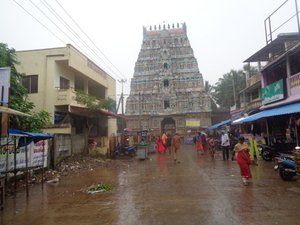Advertisement
Published: January 5th 2020

 DSC01565
DSC01565
Tirunageswaram Naganathar Temple (Rahu)24th Dec 2019
I am staying at Tanjore. I started to Kumbakonam at 8.30 am . Reached Kumbakonam at 9.45 am. After 10 minutes got the bus to Tirunageswaram . Prayed at Naganthar temple for Rahu. The main Diety is Siva
Tirunageswaram Naganathar Temple (Rahu)
Tirunageswaram Naganathar Temple also known as Rahu Stalam is a Hindu temple dedicated to the deity Shiva, located in Tirunageswaram, a village in the outskirts of Kumbakonam, a town in Tamil Nadu, India. It is significant to the Hindu sect of Saivism as one of the temples associated with the nine planet elements, the Navagraha Stalas, and specifically Rahu. Shiva is worshiped as Naganathar, and is represented by the lingam. His consort Parvati is depicted as Piraisoodi Amman. The presiding deity is revered in the 7th century Tamil Saiva canonical work, the Tevaram, written by Tamil saint poets known as the nayanars and classified as Paadal Petra Sthalam.
It houses four gateway towers known as gopurams. The temple has numerous shrines, with those of Naganathar, Rahu and Piraisoodi Amman being the most prominent. The temple complex houses many halls; the most notable is the ornamental entrance hall built during the Nayak

 DSC01566
DSC01566
Tirunageswaram Naganathar Temple (Rahu)period.
The temple has six daily rituals at various times from 5:30 a.m. to 10 p.m., and twelve yearly festivals on its calendar.
Legend Thirunageswaram is one of the many temple towns in the state which is named after the grooves, clusters or forests dominated by a particular variety of a tree or shrub and the same variety of tree or shrub sheltering the presiding deity. The region is believed to have been covered with Chamapaka forest and hence called Chamapakavanam.
Many serpents, including Adishesha, Takshaka and Karkotaka, worshipped Shiva at this place, leading to the name "Tirunageswaram". As per Hindu legend, the king of snakes, Adisesha did penance at this place, called Senbaranya Kshetram on account of the presence of large number of Senbaga trees. Shiva was pleased by the penance and appeared to him. Since Shiva gave a boon to the king of Serpents, he is called Naganathar. A Goddess Girigujambal is believed to be worshipping Shiva here with goddesses Lakshmi, Saraswathi, Ganesha, Muruga, and Shasta. Maha Bhairava is still believed to be guarding and assisting the divine mother during her prayers. The Goddess is said to be Swayambu as she is present in

 DSC01567
DSC01567
Tirunageswaram Naganathar Temple (Rahu)the form of Meru. Hence, no abhishekam (ablution) is performed for the image. As per a Hindu legend, Indra was cursed by sage Gautama as he misbehaved with the latter's wife Ahalya. To obtain deliverance from the sage's curse, it is said that Indra worshipped Giri-Gujambigai with a scented material termed Punugu for 45 days. Sages like Gautama and Parashara and kings like Bhagiratha and Nala are said to have worshipped Naganathar at this place.
The name "Kumbakonam", roughly translated in English as the "Jug's Corner", is believed to be an allusion to the mythical pot (kumbha) of the Hindu god Brahma that contained the seed of all living beings on earth. The kumbha is believed to have been displaced by a pralaya (dissolution of the universe) and ultimately came to rest at the spot where the town of Kumbakonam now stands. The drops of nectar are believed to have fallen onto five shrines around Kumbakonam, namely Mahlingeswarar temple at Tiruvidaimarudur, Tirudharasuram, Naganathar Temple at Tirunageswaram, Tiruvorgam and Tirupadalavanam.
Agniswarar Temple, Kanjanur (Kanjanoor Sukkiran Temple) I returned from Tirunageswaram to Kumbakonam. I boarded the bus to Chidambaram. Got down at Aduthurai. Got a connection bus to Panthalloor.

 DSC01568
DSC01568
Tirunageswaram Naganathar Temple (Rahu)Got down at Kanjanur
The Agniswarar Temple is a Hindu temple in the village of Kanjanur, 18 kilometers north-east of Kumbakonam. The presiding deity is Sukra (Venus). However, the main idol in the temple is that of "Agniswarar" or Shiva. In concordance with the Saivite belief that Shiva is all-pervading, Sukra is believed to be located within the stomach of the idol of Shiva.
The temple was built by the Medieval Cholas and renovated by the kings of the Vijayanagar Empire. The temple has a 5-tier rajagopuram surrounded by two prakarams (closed precincts of a temple). The temple is revered by the verses of Appar and hence referred to as Padal petra stalam. It is one of the shrines of the Vaippu Sthalams sung by Tamil Saivite Nayanar Appar
Legend is that Siva blessed Parasara muni (sage) here with cosmic dance. It is believed that Shiva appeared in the form of Sukra to propitiate himself off the dosha of Sukran.
The temple is one of the nine Navagraha temples of Tamil Nadu and is a part of the popular Navagraha pilgrimage in the state - it houses the image of Sukra (Venus)

 DSC01569
DSC01569
Tirunageswaram Naganathar Temple (Rahu)
From Kanjanoor boarded the bus to Mailaduthurai and got down there. From Mailaduthurai boarded a bus to Poompuhar and got down at Keezhaperumpallam
The Naganatha Swamy Temple or Kethu Sthalam is a Hindu temple in the village of Keezhaperumpallam, 2 kilometers from Poompuhar. The presiding deity is Ketu, a shadow planet. However, the main idol in the temple is that of "Naganatha Swamy" or Shiva.
The temple has a 2-tier rajagopuram surrounded by two prakaram(closed precincts of a temple).
The temple is one of the nine Navagraha temples of Tamil Nadu and is a part of the popular Navagraha pilgrimage in the state - it houses the image of Ketu.
Swetharanyeswarar Temple (Budhan) -Tiruvenkadu
From Keezhaperumpallam took an auto to Dharmakulam. From there boarded a bus to Tiruvenkadu (The bus destination was Sirkali) got down at Tiruvenkadu.
Swetharanyeswarar Temple is a Hindu temple dedicated to the deity Shiva, located in Thiruvenkadu, a village in Nagapattinam district in the South Indian state of Tamil Nadu. Shiva is worshiped as Swetharanyeswarar, and is represented by the lingam. His consort Parvati is depicted as Brahmavidyambigai. The presiding

 DSC01570
DSC01570
Tirunageswaram Naganathar Temple (Rahu)deity is revered in the 7th century Tamil Saiva canonical work, the Tevaram, written by Tamil saint poets known as the Nayanars and classified as Paadal Petra Sthalam. It is significant to the Hindu sect of Saivism as one of the temples associated with the nine planet elements, the Navagraha Stalas, and specifically Budha.
The temple complex covers around two acres and entered through a seven-tiered gopuram, the main gateway. The temple has a number of shrines, with those of Swetharanyesarar, Aghora and that of Nataraja, being the most prominent. All the shrines and the three temple tanks of the temple are enclosed in large concentric rectangular granite walls.
The temple has six daily rituals at various times from 6:00 a.m. to 8:00 p.m., and four-yearly festivals on its calendar. Chitra Pournami and Aani Thirumanjanam during the Tamil month of Aaani (June–July) are the most prominent festivals celebrated in the temple.
The original complex is believed to have been built by Cholas, while the present masonry structure was built by Vijayanagar kings during the 16th century. In modern times, the temple is maintained and administered by the Hindu Religious and Charitable Endowments Department of the Government of

 DSC01571
DSC01571
Tirunageswaram Naganathar Temple (Rahu)Tamil Nadu.
Legend Swetharanyeswarar is the main God in this temple. It is said that Agora Murthi was one of the furious incarnations of Shiva. There was a demon named Maruthuvasuran in Thiruvengadu. He performed penance to please Brahma for attaining special powers. Pleased by his devotion, Brahma offered him special powers. Maruthuvasuran started misusing his powers to torture the saints and innocent people. All the suffering saints and people requested Shiva to put an end to their hardship. Shiva took an incarnation as Agora murthi and killed Maruthuvasuran under a tree which is believed to be the place where Thiruvengadu temple is located. The place is called by other names like Swetaranyam, Adi Chidambaram and Nava Ntirya Stala. Indran, Airavatan, Budha, Sooriyan and Chandiran are said to have worshipped Swetharanyeswarar here.
As per another legend, Achyutha Kalappalar, a local chieftain was childless. His guru Sivacharya analyzed his horoscope and read out an ancient palm leaf manuscript. It had the verse of Sambandar, one of the major Saivite saints Nayanars. Chieftain was advised to pray at Venkadu to be blessed with a progeny. He prayed at the place along with his wife and was blessed with a

 DSC01575
DSC01575
Tirunageswaram Naganathar Temple (Rahu)boy. The boy later went on to write Sivagnana Bodham.
As per Hindu legend, Budhan, was the child of Chandran and Dharai. Dharai was originally the wife of Guru, but had an illicit relationship with Chandran. Dharai was directed by Shiva and Brahma to back to his husband Guru and she entrusted the child to Chandra. Budha grew up to learn his background and started hating his father Chandra. He did severe penance praying Shiva. Pleased by his devotion, Shiva blessed him to be a Navagraha.Brahma was blessed with divine power of learning (Vidya) by goddess Parvathi in the temple. Pillai Idikki Amman, an idol depicted holds a child on her hip is believed to be the depiction of Parvathi holding the child Sambandar when the latter called her Amma.
History From the stone inscriptions found inside this temple, it can be seen that the earlier Chola kings Aditya Chola and Rajaraja Chola made a lot of contributions to this temple. There are several shrines of significance in this well-visited temple, including those to Durga and Kali. The image of Natarajar here is of great beauty. Worship to Aghoramurthy (Veerabhadrar) is said to be of significance on

 DSC01576
DSC01576
Tirunageswaram Naganathar Temple (Rahu)Sunday nights in this temple. As found in Chidambaram, there is also a shrine for Lord Vishnu near the shrine for Natarajar. This temple is known as Adi Chidambaram because before Shiva first danced here before dancing in Chidambaram. The temple has around a hundred stone inscriptions from various dynasties from Cholas, Pandyas and Vijayanagara Empire king Krishnadevaraya. The major kings who are believed to have bestowed endowments in the temple are that of Raja Raja Chola I (985 - 1014), Rajendra I (1012–1044), Virarajendra (1063–1070), Kulothunga I (1070-1120), Kulesekara Pandya and Vikrama Pandya
From here returned to Mailaduthurai. From Mailaduthurai to Tanjore took 2 & 1/2 hours
Advertisement
Tot: 0.128s; Tpl: 0.015s; cc: 9; qc: 45; dbt: 0.0502s; 1; m:domysql w:travelblog (10.17.0.13); sld: 1;
; mem: 1.2mb




















